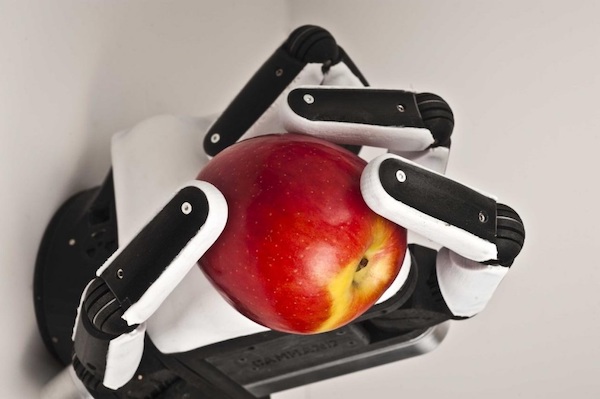Labor is a significant challenge for today’s distribution centers. The number of available jobs is growing, but the pool of candidates is not. In 2017, McKinsey noted:

In the paper, Honeywell states, “In the past, high costs or complexity have held many distribution centers back. Today, however, two encouraging developments are changing the game. First, costs are coming down. Second, DC automation is finally coming of age”.
“Soft” robots can grasp perishable and fragile items. Image: Sandia National Labs.
But “soft” robots are much more sophisticated. They can safely grasp perishable and fragile items such as eggs, fruit, and bottles. The latest models can carefully manipulate items with human hand-like dexterity.
Massachusetts-based Soft Robotics designs and builds automated ecommerce picking solutions using grippers, 3D perception, and artificial intelligence.
Soft-hands in Practice
Automation can help create jobs. Tasks will remain that require a higher intellectual level than robots. A reduction in low-grade jobs likely means an increase in skilled technicians. Someone has to design, make, and maintain the robots.
For decades, manufacturing and industrial warehouses have used “hard” robots. They handle repetitive tasks and heavy lifting, resulting in improved efficiency and fewer errors. But they are limited in what they can do. Variations in the size, shape, and pliability of objects create picking and packing challenges.
Mordor Intelligence, a research and advisory firm, valued the worldwide soft robotics market at roughly 0 million in 2019 and .7 billion by 2025. Key technologies such as sensors and vision, mobile technology, and the application of artificial intelligence, are driving this growth.

Benefits
Decreasing human error and improving efficiency are the main reasons for using robots. A robot can run for thousands of hours without stopping. Robots can do difficult, awkward, and sensitive jobs. Robots can operate in tiny spaces and have a large reach.
[embedded content]
Another Soft Robotics customer, Just Born Quality Confections, a U.S.-based candy manufacturer, uses three food-safe gripper configurations to handle 13 SKUs. The system eliminates manual picking. The soft grip technology allows delicate candy marshmallow bunnies to be picked and placed with a millimeter, showing no marks or damages. The robot can complete 360 picks per minute for the bunnies and other 2-D products and 450 ppm for 3-D versions.
Robotic technology can automate the handling, scanning, and loading of unstructured items into polybags or self-sealing mailer bags and streamline the returns handling process.
In short, soft robots could transform fulfillment in many ecommerce warehouses.
Interestingly, warehouses and distribution centers have not implemented robots in large numbers. But that is changing. Honeywell, a leader in robotic products, has recently published “The Business Case for Robotics in Distribution Centers,” a PDF whitepaper.
Job Losses
Moreover, developers are making intelligent hands that can identify produce that is too ripe or moldy, just by touch. Dynamic grasping techniques allow robot hands to sensitively handle other tricky products such as hazardous chemicals and awkwardly shaped containers.
- “Widespread automation is inevitable, but it won’t happen as quickly as has been predicted.
- “Automation won’t eliminate the need for human workers; rather, it will transform day-to-day tasks, likely for the better.
- “Aging populations in many developed countries will lead to a decline in the total workforce, leaving a gap that automation will fill.”
One Soft Robotics client, Schulze & Burch Biscuit Co., a Chicago-based snack maker, now uses a gripper to pick cereal bars without damaging them. The switch increased picks from 40 to 60 per minute and, at the same time, reduced damaged items and rejects.




![Amazon Announces Prime Day Lightning Deal Submissions [2021]](https://research-institute.org/wp-content/uploads/2021/03/amazon-announces-prime-day-lightning-deal-submissions-2021-768x376.jpg)

![The Ultimate List of Data Clean Room Providers [2022]](https://research-institute.org/wp-content/uploads/2022/04/the-ultimate-list-of-data-clean-room-providers-2022-768x376.jpg)